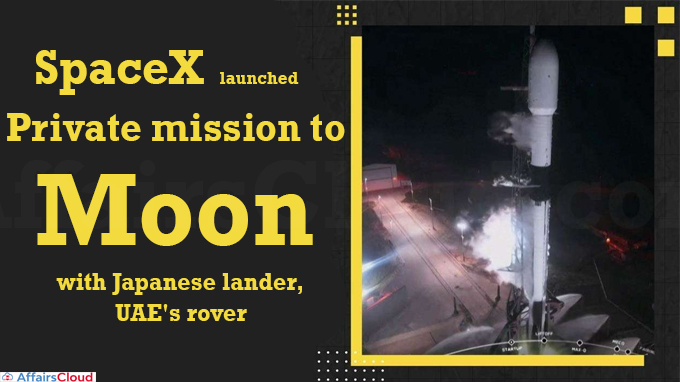 On 11th December 2022 ,Space Exploration Technologies Corp. (SpaceX) launched a mission to carry a Japanese lander named ‘HAKUTO’ , the United Arab Emirates (UAE)’s Rover named ‘Rashid’ ,and NASA’s Jet Propulsion Laboratory’s Lunar Flashlight by its Falcon 9 rocket from Cape Canaveral Space Force Station in Florida,United States.
On 11th December 2022 ,Space Exploration Technologies Corp. (SpaceX) launched a mission to carry a Japanese lander named ‘HAKUTO’ , the United Arab Emirates (UAE)’s Rover named ‘Rashid’ ,and NASA’s Jet Propulsion Laboratory’s Lunar Flashlight by its Falcon 9 rocket from Cape Canaveral Space Force Station in Florida,United States.
- The HAKUTO lander, which translates to white rabbit, is also the part of the Mission 1 by the Japanese lunar exploration company ispace. A second lunar landing by the private company ispace is planned for 2024 and a third in 2025.
- The Rashid Rover, a first Arab-built lunar spacecraft was built by Dubai’s Mohammed bin Rashid Space Centre (MBRSC), in the United Arab Emirates (UAE), and is being delivered by the HAKUTO-R lander, engineered by Japanese lunar exploration company ispace.
Key highlights:
This briefcase-sized Lunar Flashlight will enter into a near-rectilinear halo orbit, the same path that will be occupied by the small space station named Gateway that NASA plans to build as part of its Artemis I moon program.
- Artemis I aims to establish a sustainable human presence on and around the Moon, and the cubesat will hunt for water ice in shadowed craters near the moon’s south pole, which is the planned site of an Artemis I base.
About Hakuto-R:
i.The Hakuto-R lander will reach inside Atlas Crater, located on the southeastern edge of the moon’s Mare Frigoris (Sea of Cold), in April 2023.
- It carries a high-profile payload of a 22-pound (10 kilograms) robot called Rashid, the UAE’s first-ever moon rover.
ii.After its deployment Rashid will take photos with a variety of cameras and characterise the moon’s curious, electrically charged surface environment. Its mission is expected to last one lunar day (about 14 Earth days).
NASA’s Orion Completes First Flight Around Moon, Returns to Earth
NASA’s unmanned Orion spacecraft completed its first mission of the Artemis I lunar programme on 11th December 2022, travelling around the moon and back 50 years to the day after the last Apollo moon landing.
- Artemis 1 Orion spacecraft was launched from Cape Canaveral, Florida’s Kennedy Space Center atop NASA’s massive Space Launch System (SLS), the organisation’s largest rocket since the Saturn V of the Apollo period and now the most potent rocket in the world.
Key highlights:
i.Background-The gumdrop-shaped Orion spacecraft, which carried a dummy crew of three mannequins equipped with sensors, was dropped close to Guadalupe Island, off the coast of Mexico’s Baja California peninsula.
ii.The Artemis I programme intends to send men back to the moon this decade and establish a workable base on the Moon, as a stepping stone to further manned exploration of Mars.
Recent related news:
The National Aeronautics and Space Administration (NASA) confirmed the launch of its next mission Psyche on 10th October 2023, to explore the massive Golden Asteroid, worth a USD 10,000 quadrillion, that could possibly make everyone on Earth a billionaire.
About National Aeronautics and Space Administration (NASA):
Administrator – Bill Nelson
Headquarters – Washington D.C, United States




